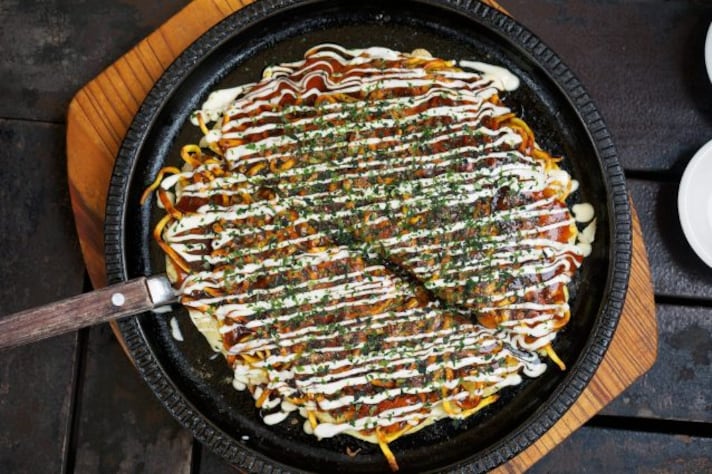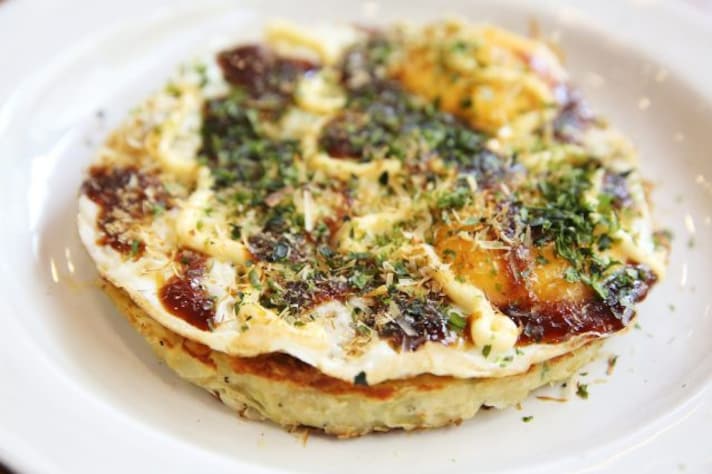What is Okonomiyaki, the Famous Japanese “Pizza”?
The so-called Osaka "pizza", or Japanese pizza. Okonomiyaki is a sweet and sour dish, similar in shape to pancakes, which dates back to the 1930s. Its paternity is divided between Osaka and Hiroshima, in Italy this dish is known thanks to two very influential anime: Kiss Me Licia and Ranma ½.

Okonomiyaki is to Osaka what pizza is to Naples. With this proportion we can well explain what the dish represents for the city in the south of Japan, also because okonomiyaki is considered the Japanese pizza. The recipe for okonomiyaki is very simple especially if you are familiar with Japanese cuisine.
The translated name says a lot about its preparation because it literally means "what you want grilled": round and flattened shape like a low pizza or an American pancake, sweet and sour flavor and a variety of toppings that have allowed this delicacy to conquer tables all over the world. There are even some city variations, a bit like the styles of pizza and the variation between the traditional Neapolitan one and the Caserta's canotto.

As with many Japanese dishes, even if they have never been tried, they can sound familiar to Westerners thanks to the countless manga and anime that have arrived over the years. This dish in particular is central to two manga that are also very famous in the world: in Kiss Me Licia, the famous cartoon from the 80s, Yaeko Mitamura, known as "Yakko" (Luciana, known as "Licia" in Italy), is a girl who works at Mambo, the typical restaurant specializing in okonomiyaki run by her father; in the manga, everything is set in Osaka, while in the anime, Tokyo was chosen as the city. The second very famous work is Ranma ½, where Ukyo Kuonji, the protagonist's beautiful admirer, is a skilled okonomiyaki cook, so much so that she always goes around with an enormous spatula that she "wears" like a katana, and is the owner of a small restaurant where she cooks the famous dish.
The History of Okonomiyaki
The cuisines of Osaka and Hiroshima compete for the paternity of the dish. According to some sources, okonomiyaki was born in the immediate post-war period in Hiroshima because, after the explosion of the atomic bomb, there was nothing left: children were therefore forced to eat the supplies that arrived with humanitarian aid, as well as adults. A sad story that tells a cross-section of the tragic catastrophe caused on August 6, 1945.
According to some historians of Japanese gastronomy, however, this paternity should be assigned to Osaka, the city par excellence of Japanese cuisine where many important chefs were trained, one above all Chef Hiro . For the city of Osaka, okonomiyaki dates back to the 1930s as an evolution of three much older dishes: funoyaki, sukesoyaki and yoshokuyaki. The first two are simple wheat pancakes, the third had condiments, sauces and, according to these historians, the original okonomiyaki has a wheat base with a topping made of meat, egg, cabbage and mayonnaise. This one was used for the first time in Osaka in 1946.

The earliest origins can be traced back to the Edo period (1683–1868), when funoyaki was created to be eaten during Buddhist ceremonies. This dish then evolved during the Meiji period (1868–1912) into a sweeter dish called sukesoyaki. During the 1920s and 1930s the dish continued to evolve, placing more emphasis on added sauces and toppings, hence the name yoshokuyaki.
The first okonomiyaki in the 1930s in Osaka were very similar to French crepes but with onions only. The first boom of the dish occurred during World War II, not after, because rice became scarce and the Japanese had to become more creative and use more readily available ingredients. A simple wheat pancake fit the bill perfectly and people then added "whatever they wanted" to this pancake.
The Two Variations of Okonomiyaki
Two cities, two similar but different dishes, both very tasty. The Osaka preparation involves cooking directly on the teppan of the table, if you are at a restaurant.

The dough is made from grated nagaimo (a type of root vegetable), dashi powder , sifted wheat flour, water, eggs, tenkasu (crispy fried flour flakes), sliced cabbage leaves, slices of raw pork belly, chopped green onion, beni shoga (minced ginger flavored with perilla sauce, a typical Japanese dish), and sakura-ebi (a type of freeze-dried shrimp found in the seas of Shizuoka Prefecture).
The Hiroshima version starts with a very shallow pancake, using a portion of the batter that contains the same ingredients as the Osaka okonomiyaki. A lot of cabbage is then added, followed by bean sprouts, and the dish is finished with the addition of yakisoba sauce and scrambled eggs, cooked on the same griddle and then placed on one or both sides of the okonomiyaki.
;Resize,width=767;)
;Resize,width=712;)
;Resize,width=712;)
;Resize,width=712;)
